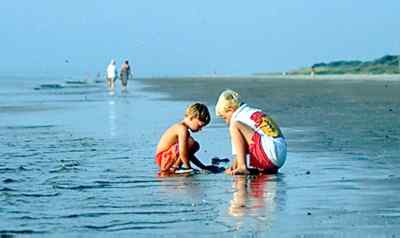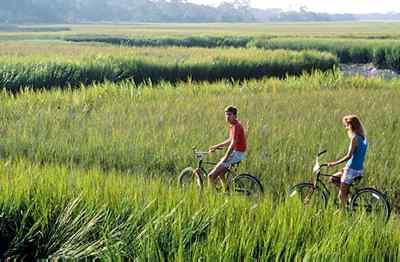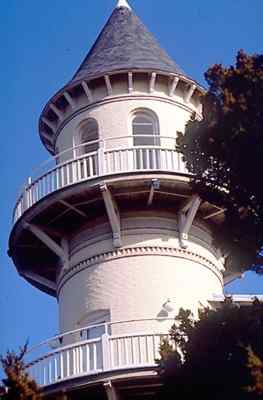
Jekyll Island State Park
[Fig. 21]
The state of Georgia owns Jekyll Island, one of only four Georgia barrier islands
reachable by car, where authorities attempt to maintain a delicate balance between
preserving the island's natural qualities and offering a full plate of outdoor
recreational opportunities. The 5,700-acre island, with 8 miles of beach and
4,400 acres of uplands, supports every kind of natural community found on a
Georgia barrier island, thus creating an outdoor classroom for the study of
island flora and fauna. Several sites on the causeway and island are on the
Colonial Coast Birding Trail. Also located on the island is the 200-acre Jekyll
Island Club National Historic District, where the richest and most powerful
men in America built an exclusive, winter hideaway from the demands of their
businesses. The natural beauty of the island, the historic district, golf, tennis,
and biking are the main attractions of the island, located only 6 miles from
Brunswick and 10 miles from Interstate 95.
While there are not as many lodging, restaurant, or shopping options as on Georgia's
other developed islands, there are fewer residents and development is limited
to one-third of the island, producing a wilder experience. About 20 miles of
trails are available to hikers, joggers, and bikers, where they can experience
firsthand the beautiful native flora and fauna of Georgia's beaches, dunes,
maritime forests, marshes, creeks, and salt flats. Because the island is a state
park, a small parking fee is charged at the entrance to the island. Not as tacky
as Tybee, or sumptuous as St. Simons and Sea Island, this island with controlled
development and outstanding natural areas might be just right for you.
Jekyll, a relatively small island measuring 7 miles long and 1.5 miles wide,
consists of both Pleistocene and Holocene components, which has affected natural
communities on the island as well as developmental patterns. The richer, older
Pleistocene soils (35,000 years old) support a greater diversity of species
and attracted farming and timbering activities during the plantation period
of the island's recent history. The younger, Holocene soils (5,000 years old),
found at the northern end past Clam Creek and at the southern end in the form
of dunes and sloughs of a recurved spit, are eroding southward. Under normal
conditions, the northeastern end would feature extensive shoals, but sands migrating
from islands to the north are trapped by a man-made trench, which allows large
ships into Brunswick harbor. The northeast end features a beautiful boneyard
beach, where a maritime forest of live oak is being undercut by currents and
tides. At the south end, developing dune systems make a living laboratory for
plant succession.
 From
eastern beach to western marsh, the mix of natural communities supports an impressive
array of animal species. Atlantic bottle-nosed dolphins are commonly observed
surfacing for air in Jekyll Creek, and deer and raccoons are abundant. Over
the last 10 years, the beaches of Jekyll have provided critical nesting grounds
to an average of 100 threatened sea turtles a year. Shells and marine creatures
wash up on the beaches, such as knobbed whelks, mermaid purses, horseshoe crabs,
and whelk egg cases.
From
eastern beach to western marsh, the mix of natural communities supports an impressive
array of animal species. Atlantic bottle-nosed dolphins are commonly observed
surfacing for air in Jekyll Creek, and deer and raccoons are abundant. Over
the last 10 years, the beaches of Jekyll have provided critical nesting grounds
to an average of 100 threatened sea turtles a year. Shells and marine creatures
wash up on the beaches, such as knobbed whelks, mermaid purses, horseshoe crabs,
and whelk egg cases.
Several species of marine creatures are found living in the intertidal zone
such as ghost shrimp, mole crabs, and coquina clams. At the base of the primary
dunes, quarter-sized holes are evidence of ghost crabs, which feed on tiny organisms
in the wrack at night. Freshwater ponds, including those on the golf courses,
are refuges for alligators, turtles, frogs, and snakes. Bird life is abundant
across the island, including many shorebird, waterfowl, and songbird species.
Woodpeckers and owls are observed in the woodlands, and hawks and vultures are
seen gliding on warm currents in the sky.
Like Georgia's other barrier islands, shell mounds are evidence that the island
was a popular hunting ground for Indians on the coast. However, during the Spanish
mission period from 1560 to 1680, Jekyll Island had no major Indian settlements
and consequently the Spanish never established a mission there. (Earlier histories
supply Jekyll with an Indian name, an Indian village, and a Spanish mission,
but new research proves these accounts are wrong.) The original Indian name
for the island is lost to history. The Spanish called it Isla de Ballenas,
which translates to "whale island," referring to the fact that the
waters in this area were (and are to this day) breeding grounds for right whales.
During the 1600s and first half of the 1700s, Georgia became known as "the
debatable land" as Spain and England struggled to control the new territory.
England sent Gen. Oglethorpe and 114 colonists to Georgia to establish a foothold.
Oglethorpe established towns and fortifications along the coast, including Savannah,
Darien, and Frederica on St. Simons.
Oglethorpe named Jekyll Island in honor of his friend Dr. Joseph Jekyll who
was the greatest contributor to the new colony. On Jekyll Island, Oglethorpe
established a forward observation post commanded by Maj. William Horton. Horton
grew rye and hops on 222 acres for the purpose of brewing beer for English soldiers.
Rum was forbidden in the new colony, but beer was not. Ruins of Horton's brewery
can still be seen on the island today.
Not wanting his enemy to see his Frederica fortifications, Oglethorpe used Jekyll
as a neutral meeting ground for English and Spanish negotiations. After the
Battle of Bloody Marsh on St. Simons in 1742, the Spanish relinquished their
claims on Georgia, but stopped on Jekyll first and destroyed Horton's home.
Horton rebuilt, but left the island in 1(912) 748 for a new plot of ground near
the Ogeechee River.
After Horton's death, the island passed through several hands before being bought
by the colorful Frenchman, Christopher Poulain du Bignon, who had fought with
American patriots during the Revolutionary War. The du Bignons, in partnership
with four other French families, settled Sapelo Island first, but when the partnership
dissolved in 1793, du Bignon and several other families purchased Jekyll Island.
Eventually, du Bignon became sole owner of the island and it remained in his
family's possession for nearly a century.
The du Bignons planted sea island cotton on much of the 3,000 acres of Pleistocene
soil, which was much more fertile than the soil of Holocene portions of Jekyll.
The older portions of the island were also logged for their live oak timber,
and today have recovered in a mix of pines, younger oaks, and mixed hardwoods.
The Holocene portions were left relatively untouched. The slave-holding du Bignons
became wealthy plantation owners until the Civil War ended the plantation era
in the South.
 The
last slaves brought to America from Africa landed on Jekyll Island in 1858,
when the 114-foot racing schooner Wanderer unloaded its illegal cargo
here. The importation of slaves had been outlawed, but great profit lay in smuggling
human cargo to the South. The Wanderer picked up 490 slaves on the West
Coast of Africa and sailed to Georgia, where the Charleston, South Carolina
ship owner received as much as $600 per slave. Ironically, the slave ship was
seized during the Civil War by Union forces, fitted with guns, and used to fight
for black freedom during the war.
The
last slaves brought to America from Africa landed on Jekyll Island in 1858,
when the 114-foot racing schooner Wanderer unloaded its illegal cargo
here. The importation of slaves had been outlawed, but great profit lay in smuggling
human cargo to the South. The Wanderer picked up 490 slaves on the West
Coast of Africa and sailed to Georgia, where the Charleston, South Carolina
ship owner received as much as $600 per slave. Ironically, the slave ship was
seized during the Civil War by Union forces, fitted with guns, and used to fight
for black freedom during the war.
In 1886, du Bignon's grandson John sold the island for $125,000 to the Jekyll
Island Club, a group of the wealthiest, most powerful men in the country, ushering
in the most well-known chapter in the island's history. The club's membership
boasted some of the most famous names of American enterprise: Morgan, Vanderbilt,
Astor, Gould, Rockefeller, McCormick, Baker, Biddle, Whitney, Armour, Crane,
Goodyear, Pulitzer, Macy, and Bliss. This group's interest in Jekyll sparked
interest from other wealthy businessmen who purchased Wassaw, Ossabaw, St. Catherines,
Sapelo, and Cumberland islands for personal hunting grounds and winter retreats.
The millionaires built a village of beautiful cottages and a nine-hole golf
course. Because they owned the entire island and their activities only impacted
one-tenth of it, the major effect on Jekyll was to preserve the island for 60
years while other islands, such as Tybee and St. Simons, were being developed
as residential islands.
The Great Depression of the 1930s, World War II, and the advent of income taxes
made Jekyll much less attractive to the millionaires, who sold the island to
the state in 1947 for $675,000 to become a new state park. A causeway and bridge
were completed in December 1954, allowing much greater public access. Today,
the Jekyll Island Authority manages the island, where 65 percent is left in
a more or less natural state (including parks and picnic grounds), and the other
35 percent is developed, including motels, a convention center, residences,
businesses, public golf courses, and a water park. Some 800 people live on the
island in privately owned residences. They have a 99-year lease on their land
from the Jekyll Island Authority, which is transferable if the residence sells,
but no more property is available for housing.
Activities on the island range from scheduled nature walks to gliding down a
water slide. Visitors and vacationers will be well entertained by Jekyll's golf,
tennis, biking, horseback riding, fishing, camping, historic touring, beachcombing,
and bird-watching. Offered in stores on the island is a highly recommended field
guide to Jekyll Island titled A Guide to a Georgia Barrier Island, by
Taylor Schoettle, which makes an excellent companion to this volume and is able
to go into greater detail.
- For more information: Jekyll Island Convention and Visitors Bureau,
PO Box 13186, Jekyll Island, GA 31527. Phone (877) 453-5955.
Read
and add comments about this page
Reader-Contributed Links to the Georgia Coast and Okefenokee Book:
 From
eastern beach to western marsh, the mix of natural communities supports an impressive
array of animal species. Atlantic bottle-nosed dolphins are commonly observed
surfacing for air in Jekyll Creek, and deer and raccoons are abundant. Over
the last 10 years, the beaches of Jekyll have provided critical nesting grounds
to an average of 100 threatened sea turtles a year. Shells and marine creatures
wash up on the beaches, such as knobbed whelks, mermaid purses, horseshoe crabs,
and whelk egg cases.
From
eastern beach to western marsh, the mix of natural communities supports an impressive
array of animal species. Atlantic bottle-nosed dolphins are commonly observed
surfacing for air in Jekyll Creek, and deer and raccoons are abundant. Over
the last 10 years, the beaches of Jekyll have provided critical nesting grounds
to an average of 100 threatened sea turtles a year. Shells and marine creatures
wash up on the beaches, such as knobbed whelks, mermaid purses, horseshoe crabs,
and whelk egg cases.

 The
last slaves brought to America from Africa landed on Jekyll Island in 1858,
when the 114-foot racing schooner Wanderer unloaded its illegal cargo
here. The importation of slaves had been outlawed, but great profit lay in smuggling
human cargo to the South. The Wanderer picked up 490 slaves on the West
Coast of Africa and sailed to Georgia, where the Charleston, South Carolina
ship owner received as much as $600 per slave. Ironically, the slave ship was
seized during the Civil War by Union forces, fitted with guns, and used to fight
for black freedom during the war.
The
last slaves brought to America from Africa landed on Jekyll Island in 1858,
when the 114-foot racing schooner Wanderer unloaded its illegal cargo
here. The importation of slaves had been outlawed, but great profit lay in smuggling
human cargo to the South. The Wanderer picked up 490 slaves on the West
Coast of Africa and sailed to Georgia, where the Charleston, South Carolina
ship owner received as much as $600 per slave. Ironically, the slave ship was
seized during the Civil War by Union forces, fitted with guns, and used to fight
for black freedom during the war.